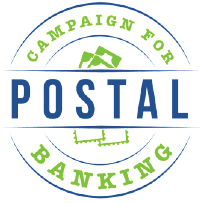Bank Closings and Lack of Confidence Point the Way to Postal Banking
November 1, 2017
 (This article first appeared in the November-December 2017 issue of the American Postal Worker magazine)
(This article first appeared in the November-December 2017 issue of the American Postal Worker magazine)
Way back in 1956, an article in the Monthly Business Review made a case for ending the Postal Savings System (see box). “It would seem that the Postal Savings System has outlived any social or economic need it may have once satisfied,” wrote the Cleveland Federal Reserve.
What were some of those social and economic needs, and do they exist today? After the financial crisis of 1907, public confidence in banks was extremely low. The Postal Savings System offered an alternative: the backing of deposits by the federal treasury and accessible locations, particularly in rural communities, where few bank branches existed. The savings program was also designed to attract the large number of recent immigrants with confidence in postal banking, as experienced in their home countries.
Old Arguments No Longer Ring True
By 1956, public confidence in banks had been restored partly due to implementation of the Federal Deposit Insurance Corporation (FDIC), protecting private bank deposits. The number of bank branches had also grown. However, here we are in 2017, on the heels of a major financial crisis, and those social and economic needs have returned – and new ones have appeared.
“Mortgage foreclosures, bank failures, a massive stock market crash, continued fraud, and excessive fees: it’s no wonder only 27 percent of Americans have confidence in banks,” remarked APWU President Dimondstein. The 27 percent is according to a 2016 Gallup Poll that was taken before we learned the full extent of the Wells Fargo fraudulent account and insurance scandal.
Banks Abandoning Communities
In addition, since the financial crisis, more than 6,000 bank branches have closed. Bank of America closed or sold 1,600 branches and 90 percent of these were located outside of large population urban areas, according to the Wall Street Journal. The loss of access to banks has increased reliance on expensive, alternative financial services, such as paycheck cashing, and has a negative impact on lending to small businesses.
Overall, 82 percent of all bank branch closings were in urban zip codes. But rural areas are also hard hit. New banking deserts – an area where there are no banks within ten miles – are in an additional 86 rural locations since the financial crisis, according to a new report from the National Community Reinvestment Coalition.
Postal Banking: The Time is Now
Financial crisis, lack of confidence in banks and the closing of bank branches all combine to make a strong case for an alternative. In addition, predatory “alternative” financial services such as payday and title loans are increasingly filling the void left by the banks.
Sound familiar? Postal banking is more needed than ever. The U.S. Postal Service is the most trusted federal agency. Providing basic financial services at the post office will serve individuals, underserved by traditional banks. It will promote an economy that serves the people, not Wall Street, and it will strengthen and protect our public Postal Service.



